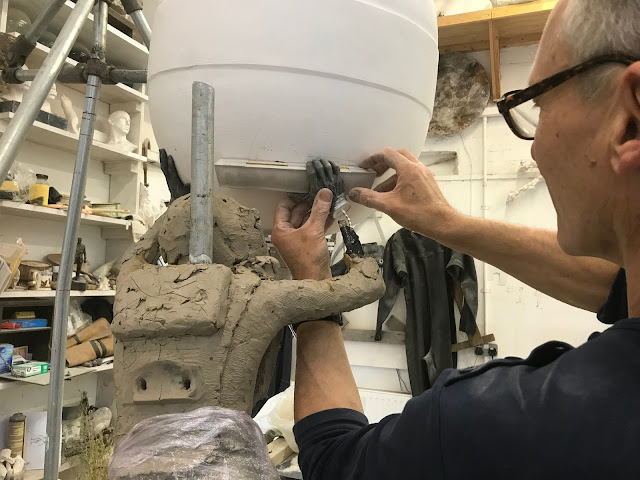Progress photos
A model poses to help me with the proportions and movement of the legs.
Fitting the charge and positioning the hands
Fitting the charge and positioning the hands
|
The charge pack here well on the way to being modelled in two-part filler. The summer heat dries out small volumes of clay and so, wherever possible I try to use non-water-based materials.
The shackle is fitted to the base of the mine.
Now the movements and proportions are in place, and the contact points set, it is time to begin refining the anatomy.
It's that work experience time of year again...here 15 year old Tish is spending a week in the studio. Her first task is to reduce one of the gas bottles to half-life size.
Tish recording the dimensions of the mask so that I can raise it up and retain the proportions
At last, I feel that I have got the composition flowing and the contact points ready to present to the structural engineer, Darren Paine, for comment and revision. The right-hand diver looks as if he has the chain place-holder in his left hand...it is in fact behind him and only there to indicate to Darren that there will be a vertical support here.
Mould for the gas bottles
Making a mould of the gas bottles...so that I don't have to make them twice over. I will cast these to plaster and fix them to the clay figures. The bottles, valves, and pipes are fiddly to make at half actual size and quite fragile so they will all be made from robust materials and moulded to double up when possible.
Now both figures are blocked out, the task begins to make them work anatomically.
Re-modelling the legs and fitting the revised fin armatures.
Cutting, bending and welding.
The legs of the right-hand diver lack movement so I set about making adjustments.
The legs of the right-hand diver lack movement so I set about making adjustments.
Now roughly blocked out, it's time to review the composition from every angle
Now roughly blocked out, it's time to review the composition from every angle
Now roughly blocked out, it's time to review the composition from every angle
Now roughly blocked out, it's time to review the composition from every angle
Now roughly blocked out, it's time to review the composition from every angle
Now roughly blocked out, it's time to review the composition from every angle
Now roughly blocked out, it's time to review the composition from every angle
Blocking out right hand diver
I have been asked why the clay figures have poles running up through them. This is to take the weight of the work while I move parts around and the reason they protrude from the top is so that I can turn the figures upside down to work on the underside.
Blocking out the left hand diver
Armatures for the half-life hands. Resin setting before being bent into position.
2 of the 4 hands cast for reference
Plaster moulds for two of the 4 reference hands.
Exploring the movement of the left hand diver. I hope to get a feel of the legs propelling laterally as well as up ad down.
|
| 5th June 2019. I am thinking of the D-Day commemorations in Portsmouth today. I only have to imagine myself in one of those landing craft, underwater (and perhaps one of the first ashore as the RN divers were) or flying into the unknown to be overwhelmed with gratitude for the courage it must have taken to plunge into what must have been a scene of terrifying uncertainty. We owe so much to that generation. God bless them all. |

















































Wow, so much has progressed, looking fantastic
ReplyDelete